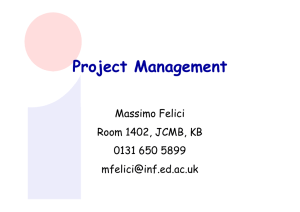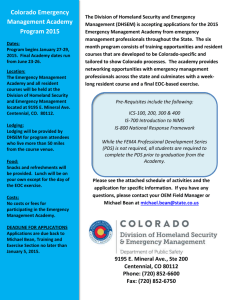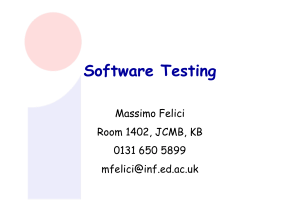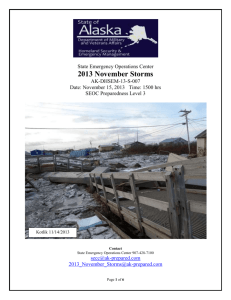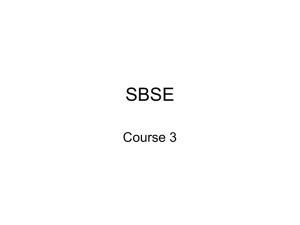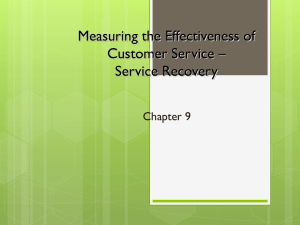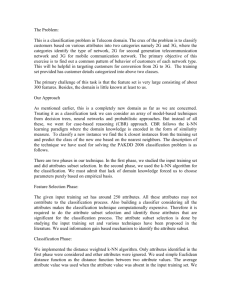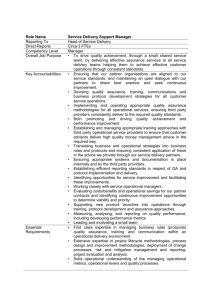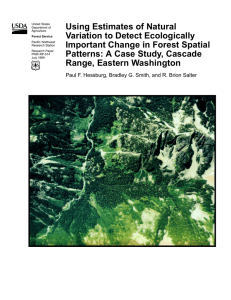Lecture Note 20
advertisement
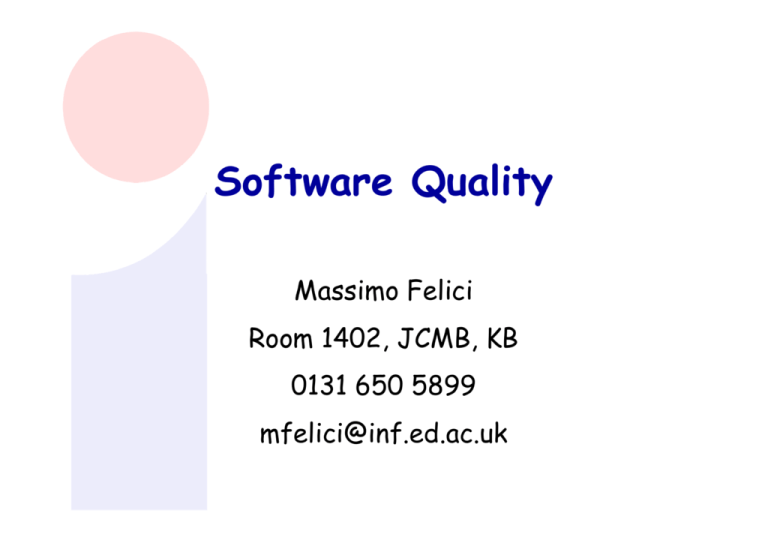
Software Quality Massimo Felici Room 1402, JCMB, KB 0131 650 5899 mfelici@inf.ed.ac.uk Software Quality at a Glance Software Quality Software Quality Fundamentals Software Quality Management Process Practical Considerations Software Engineering Culture and Ethics Software Quality Assurance Application Quality Requirements Value and Costs Of Quality Verification and Validation Defect Characterization Models and Quality Characteristics Reviews and Audits Software Quality Management Techniques Software Quality Measurement Quality Improvement © 2004-2006 SEOC - Lecture Note 20 2 Software Quality Fundamentals Commitment to Software Quality as part of organisation culture The notion of “quality” is difficult • Identification of quality characteristics, attributes and targets Quality cost Modelling Software Quality • Process and Product quality • It is difficult (may be, not entirely possible) to distinguish process quality from product quality © 2004-2006 SEOC - Lecture Note 20 3 Process and Product Quality A fundamental assumption of quality management is that the quality of the development process directly affects the quality of the delivered products The link between software process quality and software product quality is complex Process quality management involves • Defining process standards such as how and when reviews should be conducted • Monitoring the development process to ensure that the standards are being followed • Reporting the software process to project management and to the buyer of the software © 2004-2006 SEOC - Lecture Note 20 4 Software Quality Management Processes Planning software quality involves • defining the required product in terms of its quality (internal and external) characteristics • Planning the processes to achieve the required product Characteristics that govern how the product works in its environment are called external, which include, for example, usability and reliability Characteristic related to how the product was developed are called internal quality characteristics, and include, for example, structural complexity, size, test coverage, and fault rates © 2004-2006 SEOC - Lecture Note 20 5 Software Quality Management Processes Quality assurance process: ensuring that the software products and processes in the project life cycle conform to their specified requirements by planning, enacting, and performing a set of activities to provide adequate confidence that the quality is being built into the software Verification and validation processes: assessing software products throughout the product lifecycle Review and audit processes: involving Management reviews, Technical reviews, Inspections, Walkthrough and Audits © 2004-2006 SEOC - Lecture Note 20 6 Quality Planning Quality planning is the process of developing a quality plan for the project A quality plan involves • Product introduction: A description of the product, its intended market and the quality expectation for the product • Product plans: The critical release dates and responsibilities for the product along with plans for distribution and product servicing • Process descriptions: the development and service processes that should be used for product development and management • Quality Goals: The quality goals and plans for the product including an identification and justification of critical product quality attributes • Risks and risk management: The key risks that might affect product quality and the actions to address these risks © 2004-2006 SEOC - Lecture Note 20 7 Quality Assurance and Standards Quality assurance is the process of defining how software quality can be achieved and how the development organization knows that the software has the required level of quality Quality assurance standards • Product standards • Product standards Software standards • Are based on knowledge (“best-practice” or “state-of-the-art”) • Provide a framework for implementing a quality assurance process • Assist/support continuity in practice within an organization Issues: Software engineers sometimes dislike standards • Need to involve software engineering in the selection of standards • Review and modify standards regularly to reflect changing technologies • Provide software tools to support standards where possible © 2004-2006 SEOC - Lecture Note 20 8 A Brief Introduction to Software Metrics Measurement Measurement is the process by which numbers or symbols are assigned to attributes of entities in the real world in such a way as to describe them according to clearly defined rules • Measurement is a direct quantification • Calculation (or indirect measurement) is indirect Issues. Unfortunately, most software development processes • Fail to set measurable targets for software products • Fail to understand and quantify the component costs of software projects • Fail to quantify and predict the quality of the produced product • Allow anecdotal evidence to convince us to try yet another revolutionary new development technology, without doing pilot projects to assess whether the technology is efficient and effective Tom Gilb’s Principle of Fuzzy Targets: projects without clear goals will not achieve their goals clearly Tom DeMarco’s Principle: You cannot control what you cannot measure © 2004-2006 SEOC - Lecture Note 20 10 The Basics of Measurement Measurement: a mapping from the empirical world to the formal, relational world A measure is the number or symbol assigned to an entity by this mapping in order to characterise an attribute • Direct and Indirect measurement • Direct measurement of an attribute of an entity involves no other attribute or entity Measurement for prediction. A prediction system consists of a mathematical model together with a set of prediction procedures for determining unknown parameters and interpreting results Measurement scales (mappings between measurement and empirical and numerical relation systems) and scale types (e.g., nominal, ordinal, interval, ratio, absolute, etc.) © 2004-2006 SEOC - Lecture Note 20 11 Classifying Software Measures Relevant software entities • Processes are collection of software related activities • Products are any artifacts, deliverables or documents that result from a process activity • Resources are entities required by a process activity Internal attributes of a product, process or resource are those that can be measured purely in terms of the product, process or resource itself. In other worlds, an internal attribute can be measured by examining the product, process or resource on its own, separate from its behaviour External attributes of a product, process or resource are those that can be measured only with respect to how the product, process or resource relates to its environment. Here, the behaviour of the process, product or resource is important, rather than the entity itself. © 2004-2006 SEOC - Lecture Note 20 12 Determining What to Measure: GQM Goal-Question-Metric (GQM) is an approach to selecting and implementing metrics The GQM approach provides a framework involving three steps 1. List the major goals of the development or maintenance project 2. Derive from each goal the questions that must be answered to determine if the goals are being met 3. Decide what metrics must be collected in order to answer the questions adequately © 2004-2006 SEOC - Lecture Note 20 13 Measurement and Process Improvements Measurement enhances visibility into the ways in which processes, products, resources, methods, and technologies of software development relate to one another Level 5 Optimizing Level 4 Managed The Software Engineering Institute (SEI)’s Capability Maturity Model (CMM) consists of five maturity levels • • • • • Level Level Level Level Level 1: 2: 3: 4: 5: Initial Repeatable Defined Managed Optimizing Level 2 Repeatable Level 1 Initial Other models: ISO 9000, SPICE, etc. © 2004-2006 Level 3 Defined SEOC - Lecture Note 20 14 Software Measurement Validation Validating a prediction system in a given environment is the process of establishing the accuracy of the prediction system by empirical means. That is, by comparing model performance with known data in the given environment. Validating a software measure is process of ensuring that the measure proper numerical characterization of claimed attribute by showing that representation condition is satisfied. © 2004-2006 SEOC - Lecture Note 20 the is a the the 15 Empirical Investigation Software Engineering Investigations 1. Experiments: research in the small 2. Case Studies: research in the typical 3. Surveys: research in the large State hypothesis and determine how much control is needed over the variables involved 1. If control is not possible, the a formal experiment is not possible 2. Then a case study may be a better approach 3. If the study is retrospective, then a survey may be done State Six stage of an experiment: conception, design, preparation, execution, analysis and dissemination © 2004-2006 SEOC - Lecture Note 20 16 Software Metrics Data Collection What is Good Data? • • • • • • Correctness: Are they correct? Accuracy: Are they accurate? Precision: Are they appropriately precise? Consistency: Are they consistent? Are they associated with a particular activity or time period? Can they be replicated? Software Quality Terminology • A fault occurs when a human error results in a mistake in some software product • A failure is the departure of a system from its required behaviour. Errors -> Faults -> Failures • NOTE: to many organizations, errors often mean faults Faults -> Errors -> Failures • Anomalies usually means a class of faults that are likely to cause failures in themselves but may nevertheless eventually cause failures indirectly • Defects normally refer collectively to faults and failures • Bugs refer to faults occurring in the code • Crashes are special type of failure, where the system ceases to function © 2004-2006 SEOC - Lecture Note 20 17 Problem Record An example drawn from the Therac 25 Location: Location: East Texas Cancer in Tyler, Texas, USA Timing (1): March 21 1986, at whatever the precise time that “Malfucntion 54” appeared on the screen Timing (2): total number of treatment hours on all Therac 25 machines up to that particular time Symptom (1): “Malfucntion 54” appeared on screen Symptom (2): classification of the particular program of treatment being administrated, type of tumor, etc. End result: strength of beam to great by a factor of 100 Mechanism: use of the up-arrow key while setting up the machine led to the corruption of a particular internal variable in the software Cause (1): (trigger) unintentional operator action Cause (2): (source type) unintentional design fault Severity: critical, as injury to the patient was fatal Cost: effort or actual expenditure by accident investigators where did the problem occur? Timing: when did it occur? Symptom: what was observed? End result: which consequences resulted? Mechanism: how did it occur? Cause: why did it occur? Severity: how much was the user affected? Cost: how much did it cost? © 2004-2006 SEOC - Lecture Note 20 18 Analyzing Software Measurement Data Describe a set of attribute values using box plot statistics (based on median and quartiles) rather than on mean and variance Inspect a scatter plot visually when investigating the relationship between two variables Use robust correlation coefficients to confirm whether or not a relationship exists between two attributes Use robust regression in the presence of atypical values to identify a linear relationship between two attributes, or remove the atypical values before analysis Always check the residuals by plotting them against the dependent variable Carefully transform non-linear relationships Use principal components analysis to investigate the dimensionality of data sets with large numbers of correlated attributes © 2004-2006 SEOC - Lecture Note 20 19 Measuring Internal Product Attributes Examples of Internal Attributes • Size (e.g., length, functionality, complexity, reuse, etc.) or Structure Simple measurements of size fail adequately to reflect other attributes, e.g., effort, productivity and cost Example of Length: Line Of Code (LOC) Examples of Complexity: problem, algorithmic, structural or cognitive Types of structural measures: control-flow, dataflow and data • The structure of a module is related to the difficulty in testing it © 2004-2006 SEOC - Lecture Note 20 20 Examples of Object-Oriented Metrics 1. Weighted Methods per Class (WMC): is intended to relate to the notion of complexity 2. Depth of Inheritance Tree (DIT): is the length of the maximum path from the node to the root of the inheritance tree 3. Number of Children (NOC): relates to a node (class) of the inheritance tree. It is the number of immediate successors of the class. 4. Coupling Between Object classes (CBO): is the number of other classes to which the class is coupled 5. Response For Class (RFC): is the number of local methods plus the number of methods called by the local methods 6. Lack of Cohesion Metric (LCOM): is defined as the number of disjointsets of local methods © 2004-2006 SEOC - Lecture Note 20 21 Measuring External Product Attributes Modelling Software Quality The ISO 9126 standard quality model: functionality, reliability, efficiency, usability, maintainability and portability Note: Safety is a system property, not a software quality characteristic An example: Usability of a software product is the extent to which the product is convenient and practical to use Another example: Usability is the probability that the operator of a system will not experience a user interface problem during a given period of operation under a given operational profile © 2004-2006 SEOC - Lecture Note 20 22 Software Reliability The software reliability problem • Hardware reliability is concerned with component failures due to physical wear – such failures are probabilistic in nature • The key distinction between software reliability and hardware reliability is the difference between intellectual failure (usually due to design faults) and physical failure. Reliability is defined in terms of failures, therefore it is impossible to measure before development is complete • However, carefully collected data on inter-failure times allow the prediction of software reliability Software Reliability Growth Models estimate the reliability growth • None can guarantee accurate predictions on all data sets in all environments Limitations: unfortunately, software reliability growth models work effectively only if the software’s future operational environment is similar to the one in which the data was collected © 2004-2006 SEOC - Lecture Note 20 23 Beyond Software Resource Measurement: • Productivity: • Distinguish between productivity of a process from the productivity of the resources • Should also take into account of the quality of the output A General Prediction Process • Team • Team Structure, size, communication density • Tools Making process prediction • Problems of estimations methods: local data definition, calibration, independent estimation group, reduce input subjectivity, preliminary estimates and re-estimation, alternative size measures for cost estimation, locally developed cost models © 2004-2006 SEOC - Lecture Note 20 24 Reading/Activity Please read • Chapter 11 on Software Quality of the SWEBOW. • J. Bøegh, S. De Panfilis, B. Kitchenham and A. Pasquini, A Method for Software Quality Planning, Control, and Evaluation. In IEEE Software, March/April 1999, pp. 69-77. References N. E. Fenton and S. L. Pfleeger. Software Metrics: A Rigorous and Practical Approach. Second Edition, International Thomson Computer Press, 1996. © 2004-2006 SEOC - Lecture Note 20 25 Summary Software Quality • • • • • Software fundamentals Process and product quality Software quality management process Quality planning Quality assurance and standards Software Metrics © 2004-2006 SEOC - Lecture Note 20 26
